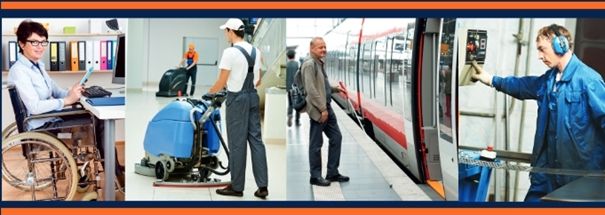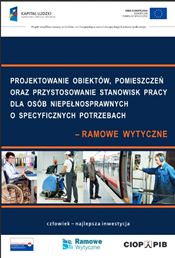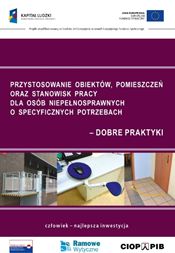Misją Instytutu jest dzialalność naukowo-badawcza prowadząca do nowych rozwiązań technicznych i organizacyjnych użytecznych w kształtowaniu warunków pracy zgodnych z zasadami bezpieczeństwa pracy i ergonomii oraz ustalanie podstaw naukowych do właściwego ukierunkowywania polityki społeczno-ekonomicznej państwa w tym zakresie.
-

Noise -

Vibrations -

Electromagnetic fields -

Static Electricity and Air Ionization -

Mechanical and Electrical Hazards -

Protective Devices and Systems -

Optical Radiation and Workstation Lighting -

Chemicals and Aerosols in the Working Environment -

Personal Protective Equipment -

Ergonomics -

Control of Major Industrial Accidents -

Occupational Safety and Health Management -

Laboratory Tests and Certification of Products -

Centre for Assessment and Development of OSH Competence -

Educational and Publishing Activities -

Communication with Society

Framework Guidelines for the design of facilities and adaptation of workstations for people with disabilities and specific needs
Introduction
Despite their systematic increase, the occupational activity rate of people with disabilities in Poland (27.3% in 2013), and the employment rate of disabled persons of working age (in 2013 - 22.4%) are still low according to the Central Statistical Office of Poland. According to data from Financing and Refund Service System, funded by the State Fund for the Rehabilitation of the Disabled, 66.4% of all disabled workers in Poland were employed in sheltered employment (in 2013).
In order to increase the social integration of disabled people, it is necessary to raise the employment rate of people with disabilities, especially in the open labour market. Among the most important reasons for the low employment rate of this group of people is that employers’ are afraid of difficulties and inconvenience due to the necessity to adapt facilities, rooms and workstations to the needs of people with disabilities.
Conviction of the need to change this approach was one of the reasons for the development of the Framework Guidelines for the design of facilities, rooms and adaptation of workstations for people with disabilities and specific needs. It is also important to stress that such actions always have a positive impact on the work organization, the psychosocial climate at work and the safety of all workers, not only the disabled.
Framework Guidelines are a compendium of knowledge both in terms of general requirements for the working environment for all employees as well as the guidelines and recommendations for its adaptation for the specific needs of the disabled person, resulting from the ergonomic assessment.
The main objective of the guidelines is to raise awareness of the disabled occupational community. They are also intended to:
- diagnose the needs and to define recommendations for the design of facilities, rooms and for the adjustment of workstations for people with disabilities and specific needs,
- raise employers' awareness of the necessity and benefits of the design of facilities and adaptation of workstations for people with disabilities and specific needs,
- improve the knowledge of occupational physicians, inspection services, architects, employers, NGOs, and other entities interested in the design of facilities and adaptation of workstations for people with disabilities and specific needs.
The issues outlined in the Framework Guidelines address workers with the following disabilities:
- Musculoskeletal system
- Sight (blindness and vision loss)
- Hearing (hearing loss and deafness)
- Mental illness (including illness resulting from disorders of the spectrum of autism)
- Intellectual
- Other (e.g. due to cardiovascular, respiratory, nervous, digestive, urogenital diseases).
The following aspects of the working environment have been included in the Framework Guidelines:
- Architectural adaptation
- Lighting and visual signaling
- Acoustics and sound signaling
- Field and electromagnetic radiation
- Physical load of workers and organization of the workplace
- Safety of machinery and equipment
- Microclimate
- Chemical agents
- Psychosocial working conditions.
The whole project results include Publications and website tools (available in Polish):
 |
 |
| Framework guidelines for designing of facilities, rooms and adaptation of workstations for people with disabilities – ISBN 978-83-7373-182-0 | |
|
Virtual reality visualization showing examples of adaptation of facilities, rooms and workstations to the needs of people with disabilities |
15 expert assessments for ergonomic assessment of facilities, rooms and workstations in terms of their adaptation for people with specific needs resulting from disability |
- A checklist for assessing the working environment of people with different disabilities
- 200 job characteristics
The authors hope that the developed material will contribute to increasing the interest in the employment opportunities of people with disabilities and will facilitate effective adaptation of the working environment to the needs of people with disabilities.
About the project:
State Fund for Rehabilitation of Disabled Persons (PFRON) was the leader of the project and CIOP-BIP was a partner. The project was carried out from 2013 to 2015. It was coordinated by Joanna Bugajska, Ph.D., D.Med.Sc. and Wiktor M. Zawieska, Ph.D. (Eng.), D.Sc. (Eng.).
